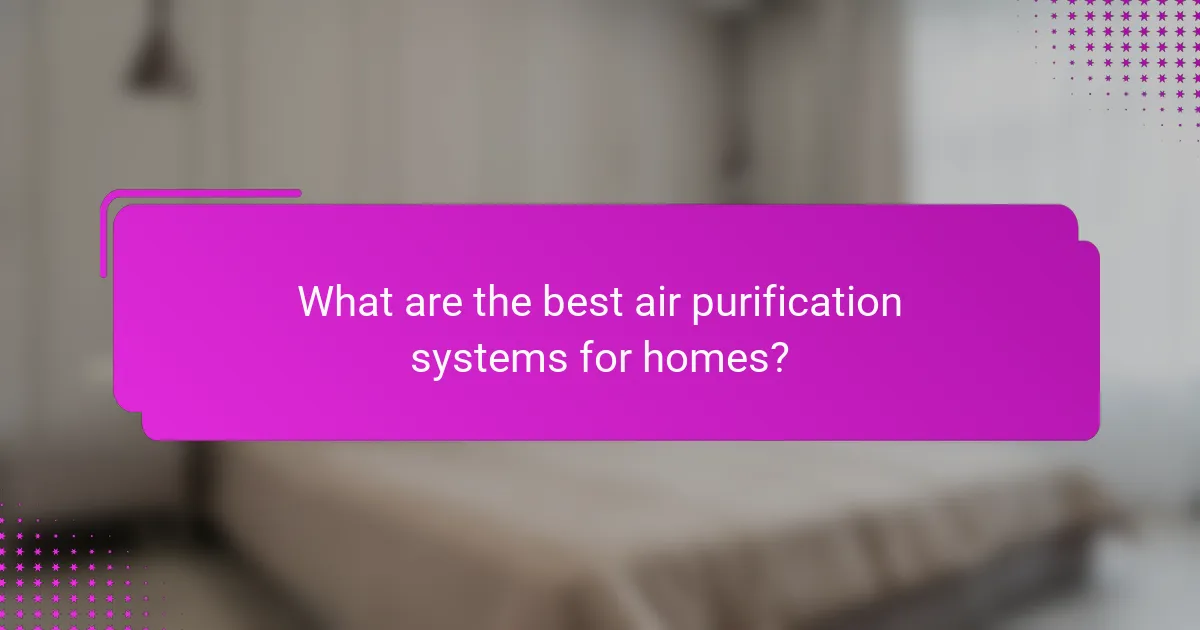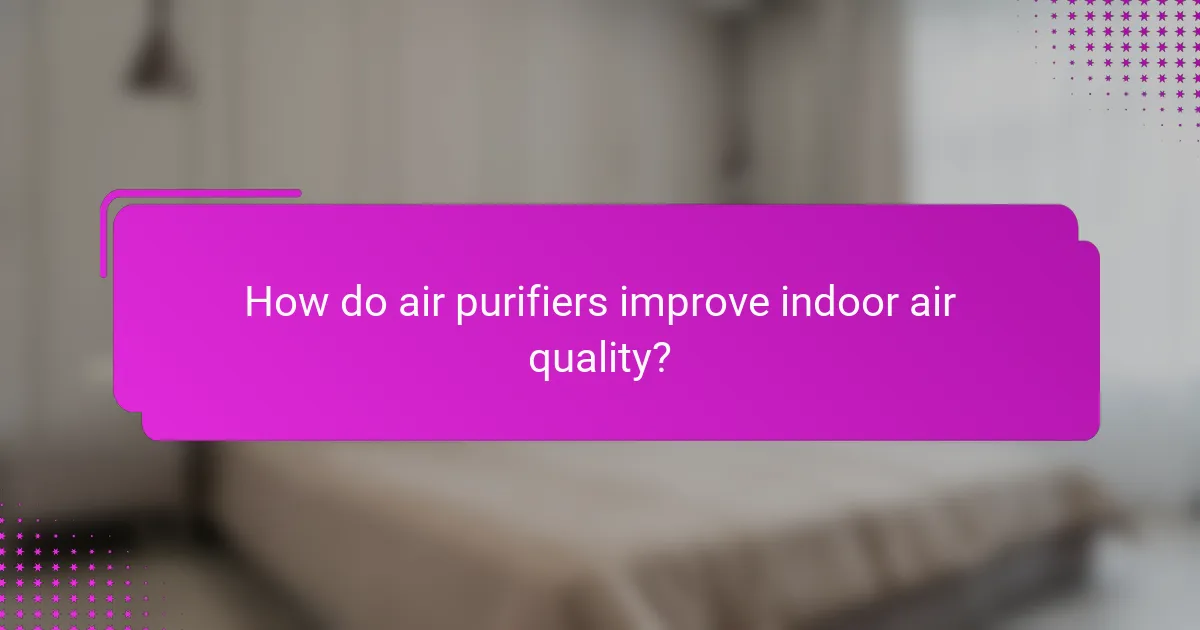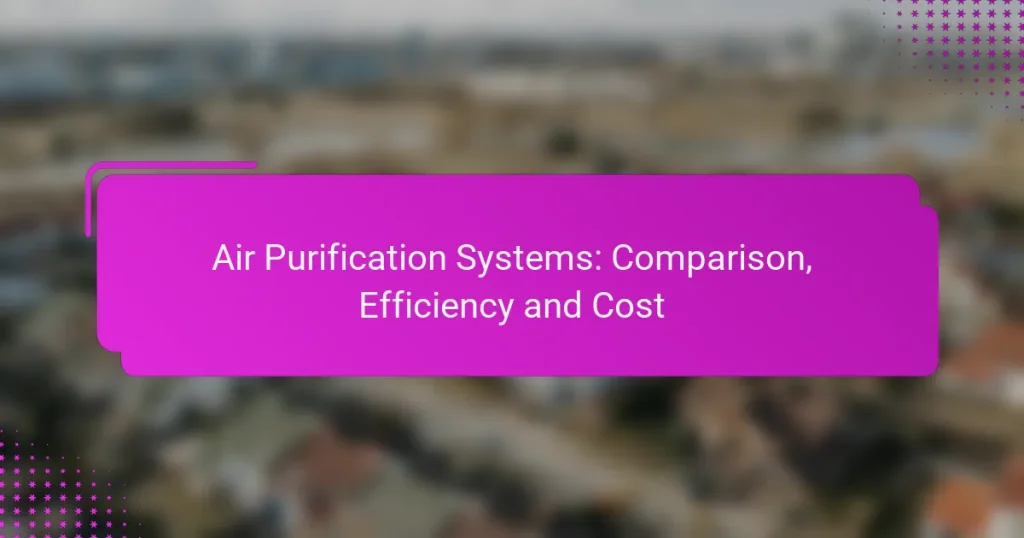Air purification systems play a crucial role in enhancing indoor air quality, with various types available, including HEPA, activated carbon, and UV-C light purifiers. Their efficiency is influenced by factors such as Clean Air Delivery Rate (CADR) and filter lifespan, which also affect overall cost-effectiveness. When selecting a system, it’s essential to consider not only the initial purchase price but also ongoing maintenance and energy consumption to gauge the total investment.

What are the best air purification systems for homes?
The best air purification systems for homes include HEPA air purifiers, activated carbon air purifiers, UV-C light air purifiers, ionizer air purifiers, and smart air purifiers. Each type has unique features and efficiencies that cater to different air quality needs and preferences.
HEPA air purifiers
HEPA (High-Efficiency Particulate Air) purifiers are known for their ability to capture at least 99.97% of particles that are 0.3 microns in size. They are effective against dust, pollen, pet dander, and smoke, making them a popular choice for allergy sufferers.
When selecting a HEPA air purifier, consider the Clean Air Delivery Rate (CADR) to ensure it suits the size of your room. A higher CADR indicates faster air cleaning, which is crucial for larger spaces.
Activated carbon air purifiers
Activated carbon air purifiers use a charcoal filter to absorb odors, gases, and volatile organic compounds (VOCs). They are particularly effective in kitchens or areas with strong smells, such as smoke or pet odors.
While they excel at odor removal, activated carbon filters do not capture particulate matter as effectively as HEPA filters. Therefore, many models combine both technologies for comprehensive air cleaning.
UV-C light air purifiers
UV-C light air purifiers utilize ultraviolet light to kill bacteria, viruses, and mold spores in the air. This technology is beneficial in reducing biological contaminants, making it suitable for homes with immunocompromised individuals.
However, UV-C purifiers should be used in conjunction with other filtration methods, as they do not remove particles from the air. Regular maintenance is also necessary to ensure the UV light remains effective.
Ionizer air purifiers
Ionizer air purifiers release negatively charged ions that attach to airborne particles, causing them to clump together and fall to the ground or be captured by filters. They can help reduce allergens and improve air quality.
One downside is that ionizers may produce ozone, which can be harmful at high levels. It’s essential to choose models that comply with safety standards to minimize this risk.
Smart air purifiers
Smart air purifiers connect to Wi-Fi and can be controlled via smartphone apps, allowing users to monitor air quality and adjust settings remotely. They often include features like air quality sensors and automatic adjustments based on real-time data.
These devices can be more expensive than traditional models, but their convenience and advanced features can justify the cost for tech-savvy consumers looking for efficient air management.

How do air purification systems compare in efficiency?
Air purification systems vary significantly in efficiency based on their design, technology, and intended use. Key factors to consider include Clean Air Delivery Rate (CADR), energy efficiency, and filter lifespan, all of which impact overall performance and cost-effectiveness.
CADR ratings
CADR ratings indicate the volume of filtered air delivered by an air purifier, measured in cubic feet per minute (CFM). Higher CADR ratings suggest better efficiency in removing specific pollutants like dust, pollen, and smoke. For optimal performance, choose a purifier with a CADR rating that matches the size of your room.
For example, a CADR of 200 CFM is suitable for rooms up to 300 square feet, while a rating of 300 CFM can effectively purify larger spaces. Always check the CADR ratings for the specific pollutants you are most concerned about.
Energy efficiency
Energy efficiency is crucial for reducing long-term operational costs. Look for air purifiers that are ENERGY STAR certified, as these models meet strict energy efficiency guidelines set by the U.S. Environmental Protection Agency. A more efficient unit can save you money on electricity bills while maintaining effective air purification.
Typically, energy-efficient models consume between 30 to 100 watts, depending on their size and features. Consider using a timer or smart features to optimize energy usage during peak hours.
Filter lifespan
The lifespan of filters in air purification systems can vary widely, typically ranging from 6 months to 2 years. HEPA filters generally last longer than pre-filters or activated carbon filters, which may need replacement more frequently. Regular maintenance is essential to ensure the system operates efficiently.
To maximize filter lifespan, follow the manufacturer’s recommendations for cleaning and replacement. Some systems feature filter change indicators, which can help you keep track of when it’s time to replace them, ensuring consistent air quality.

What are the costs of air purification systems?
The costs of air purification systems can vary significantly based on the type, brand, and features. Generally, consumers should consider initial purchase prices, ongoing maintenance costs, and energy consumption expenses to understand the total investment.
Initial purchase price
The initial purchase price of air purification systems typically ranges from a few hundred to several thousand dollars. Basic models may cost around $100 to $300, while advanced systems with HEPA filters and smart technology can exceed $1,000. It’s essential to evaluate the features and specifications to ensure the system meets your needs.
When comparing prices, consider the size of the area the unit will cover, as larger spaces may require more expensive models. Additionally, look for units that offer warranties or money-back guarantees, which can provide added value and peace of mind.
Maintenance costs
Maintenance costs for air purification systems generally include filter replacements and occasional servicing. Depending on the type of filter, replacements can range from $20 to $100 every few months. HEPA filters, while effective, often have higher replacement costs compared to standard filters.
Regular maintenance is crucial for optimal performance. Check the manufacturer’s recommendations for maintenance schedules and ensure you factor these costs into your overall budget. Neglecting maintenance can lead to decreased efficiency and higher energy costs.
Energy consumption costs
Energy consumption costs for air purification systems can vary based on the model and usage. Most units consume between 30 to 100 watts per hour, translating to approximately $5 to $15 per month in electricity, depending on local rates. Using the unit continuously will increase these costs.
To minimize energy expenses, consider models with energy-efficient ratings, such as those certified by ENERGY STAR. Additionally, using timers or smart features can help manage operation times and reduce unnecessary energy use.

What factors should you consider when choosing an air purifier?
When selecting an air purifier, consider room size compatibility, filter type and replacement frequency, and noise levels. These factors play a crucial role in ensuring effective air purification tailored to your specific needs.
Room size compatibility
Room size compatibility is essential for effective air purification. Each air purifier has a recommended coverage area, usually measured in square feet or square meters. For optimal performance, choose a model that matches or exceeds the size of the room where it will be used.
For example, if your room is around 200 square feet, look for an air purifier rated for at least that size. This ensures the unit can circulate and filter the air efficiently, removing pollutants and allergens effectively.
Filter type and replacement frequency
The type of filter used in an air purifier significantly impacts its efficiency and maintenance. Common filter types include HEPA, activated carbon, and pre-filters, each serving different purposes. HEPA filters are particularly effective at capturing small particles, while activated carbon filters help reduce odors and gases.
Consider the replacement frequency of filters, as this affects long-term costs and maintenance. HEPA filters typically last 6-12 months, while activated carbon filters may need replacement every 3-6 months. Always check the manufacturer’s recommendations to ensure optimal performance.
Noise levels
Noise levels can vary significantly among air purifiers, impacting your comfort, especially in bedrooms or quiet spaces. Most models provide a decibel rating, allowing you to compare noise output. Generally, a noise level below 30 dB is considered quiet, while levels above 50 dB may be disruptive.
When choosing an air purifier, consider how you plan to use it. If you need it to run continuously at night, prioritize models known for quieter operation. Many purifiers offer a “sleep mode” that reduces noise while maintaining air quality.

How do air purifiers improve indoor air quality?
Air purifiers enhance indoor air quality by filtering out harmful particles and pollutants, making the air cleaner and safer to breathe. They work through various technologies, including HEPA filters, activated carbon, and UV light, targeting allergens, dust, smoke, and other contaminants.
Reduction of allergens
Air purifiers significantly reduce allergens such as pollen, pet dander, and mold spores. HEPA filters are particularly effective, capturing up to 99.97% of particles as small as 0.3 microns, which is crucial for allergy sufferers.
When selecting an air purifier for allergen reduction, consider the size of the room and the Clean Air Delivery Rate (CADR). A higher CADR rating indicates faster air cleaning, which is beneficial in larger spaces.
Elimination of pollutants
Air purifiers help eliminate indoor pollutants like volatile organic compounds (VOCs), smoke, and odors. Activated carbon filters are effective in adsorbing these harmful substances, improving overall air quality.
To maximize pollutant removal, choose an air purifier with multiple filtration stages. Regular maintenance, such as changing filters according to the manufacturer’s recommendations, ensures optimal performance and longevity of the device.


